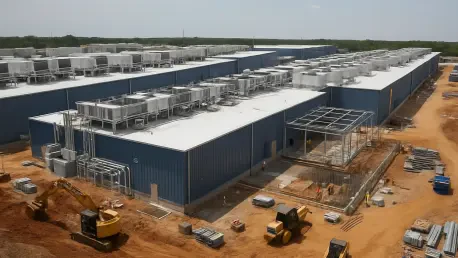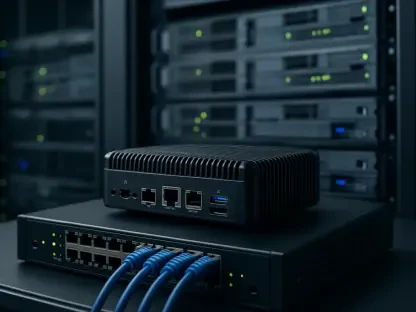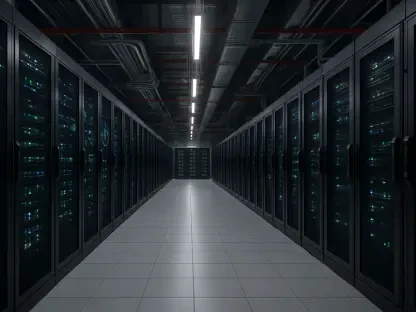Introduction
In an era where artificial intelligence and hyperscale computing are reshaping the digital landscape, the data center industry is experiencing unprecedented growth, exemplified by a staggering $38 billion investment in North Carolina by Energy Storage Solutions. This massive undertaking underscores the critical role data centers play in powering global innovation, from cloud services to cutting-edge AI applications. However, as demand skyrockets, so do the challenges of expansion, ranging from local opposition to energy constraints. This analysis delves into the surge of data center growth, examines real-world examples like the North Carolina projects, incorporates expert insights, explores future implications, and offers key takeaways on overcoming the hurdles that threaten to slow progress in this vital sector.
The Surge in Data Center Demand
Growth Trends and Industry Statistics
The data center market is witnessing explosive growth, driven primarily by the insatiable needs of AI applications and cloud computing. Industry reports indicate that the global data center market is projected to grow at a compound annual growth rate of over 10% from 2025 to 2030, reflecting a sharp increase in capacity requirements. Hyperscale facilities, which cater to tech giants, are at the forefront, accounting for a significant portion of new investments with billions poured into infrastructure annually.
This rapid expansion is fueled by the sheer volume of data generated daily, necessitating robust storage and processing capabilities. North America alone has seen a surge in data center construction, with investment trends pointing to a doubling of capacity in key regions over the next five years. These figures highlight not just the scale but the urgency of meeting technological demands in an increasingly digital world.
Real-World Case Study: North Carolina’s Mega Projects
A prime example of this trend is Energy Storage Solutions’ ambitious $38 billion initiative in North Carolina, split between two massive campuses. The flagship $19.2 billion Kingsboro campus in Tarboro spans 300 acres and boasts a 900 MW capacity, with construction set to begin in early 2026 and unfold in 24 phases over 3-5 years. A parallel project of comparable scale is underway in Fayetteville, positioning the Southeast as a new hub for data infrastructure.
These projects promise substantial economic benefits, including over 1,000 jobs per campus and an estimated $75 million in annual tax revenue for local counties like Edgecombe. Each campus will feature around a dozen 40,000-square-foot structures, designed to meet the needs of hyperscale clients. Such developments illustrate the bold scope of modern data center initiatives amid rising demand.
Navigating Local and Regulatory Obstacles
Zoning Challenges and Community Pushback
Balancing technological progress with local governance remains a significant barrier to data center expansion. In North Carolina, a crucial victory came when Edgecombe County commissioners amended zoning ordinances to allow data center construction in industrial zones, clearing the path for the Kingsboro campus. This success, however, contrasts sharply with an earlier rejection of a smaller $6.4 million project in Tarboro, where community opposition halted development.
Similar resistance is evident nationwide, with major players like Amazon facing pushback in states such as Virginia and Arizona. Concerns often center on environmental impact, noise pollution, or unfounded fears amplified by misinformation. These cases reveal a recurring pattern where local sentiment can derail projects, even those with substantial economic promise, highlighting the need for strategic community engagement.
Expert Perspectives on Balancing Interests
Industry leaders offer valuable insights into navigating these conflicts. Steven Dickens, CEO of HyperFrame Research, places local zoning disputes in a broader context, arguing that data centers are not just regional assets but critical to national and geopolitical strategies, especially in AI infrastructure competition with global powers. This perspective underscores the stakes involved beyond county lines.
Complementing this view, Dan Shaffer, President of Energy Storage Solutions, emphasizes the importance of transparency and dialogue. He advocates for educating communities about the tangible benefits of data centers, such as job creation and energy contributions, to counter misinformation. These expert opinions stress that bridging the gap between developers and residents is essential for project success.
Power and Sustainability Concerns in Expansion
Energy Demands and Innovative Solutions
Power availability is a linchpin in data center site selection, and the North Carolina projects exemplify this challenge. Both campuses will rely on natural gas for on-site power generation, supported by a $176 million investment in regional energy infrastructure upgrades. This approach ensures a stable energy supply to meet the immense demands of hyperscale operations.
Innovatively, surplus energy generated on-site will be sold back to local utilities at discounted rates, creating a mutual benefit for the region. Such strategies demonstrate how developers are adapting to energy constraints by integrating solutions that support both operational needs and local grids, setting a potential model for future expansions.
Environmental and Community Impacts
Despite these innovations, environmental concerns continue to fuel community opposition. Residents often worry about resource consumption, emissions, and the broader ecological footprint of large-scale data centers. These apprehensions, while sometimes overstated, reflect genuine fears about sustainability in an era of heightened climate awareness.
The industry as a whole faces the daunting task of aligning explosive growth with environmental responsibility. As demand escalates, the pressure to adopt greener practices intensifies, pushing developers toward renewable energy integration and other sustainable solutions. Addressing these concerns is not just a local issue but a global imperative for the sector’s long-term viability.
The Future of Data Center Expansion
Emerging Trends and Potential Developments
Looking ahead, the trajectory of data center growth suggests even larger projects on the horizon, as financial backers encourage developers to expand footprints, much like in North Carolina. The scale of investment is likely to increase, driven by the relentless pace of technological advancement and data consumption. This trend points to a future where mega-campuses become the norm.
Technological innovations, particularly in energy efficiency, could ease some expansion challenges. Advances in cooling systems and renewable energy adoption are poised to reduce operational footprints. Additionally, evolving regulatory frameworks may streamline zoning processes, provided they balance local concerns with national priorities, shaping a more conducive environment for growth.
Broader Implications and Challenges Ahead
The implications of this expansion are twofold: on one hand, data centers drive economic growth and technological leadership, positioning regions as innovation hubs. On the other hand, persistent hurdles like community resistance and environmental strain threaten to slow progress. Striking a balance between these outcomes remains a critical challenge for stakeholders.
Globally, strategic investments in data infrastructure are vital for maintaining competitiveness, yet they must align with local realities. Enhanced engagement, better planning, and policy support will be key to ensuring that expansion efforts do not falter under the weight of opposition or resource limitations, paving the way for sustainable development on a worldwide scale.
Conclusion and Call to Action
Key Takeaways from the Trend
Reflecting on the data center boom, it became evident that unprecedented demand, fueled by AI and hyperscale computing, had driven remarkable growth, with projects like those in North Carolina serving as a microcosm of industry-wide challenges. The economic and technological benefits stood out, yet so did the complex obstacles of zoning, community pushback, and sustainability. These dynamics underscored the pivotal role data centers played in shaping progress despite persistent barriers.
Looking Forward
As the industry moves forward, collaboration emerges as a cornerstone for success, with developers, communities, and regulators needing to forge stronger partnerships to address past tensions. Prioritizing education about project benefits, maintaining transparency in operations, and investing in innovative energy solutions offer a path to mitigate conflicts. Stakeholders are encouraged to focus on these actionable steps to ensure that data center expansion harmonizes with local needs, setting a precedent for sustainable growth in an ever-evolving technological landscape.









